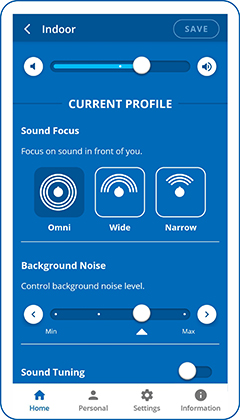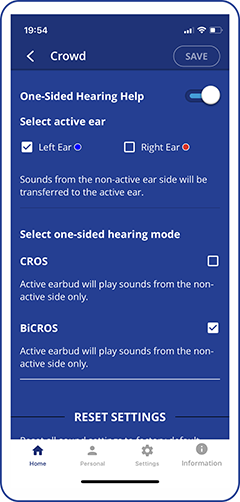Can I use BeHear if I have a pacemaker?
Yes, you can use your BeHear amplifier if you wear an ICD or pacemaker. However, we recommend that you avoid close and/or constant contact between it and the BeHear magnets or their magnetic fields. Keep the headset magnets at least 1 inch away from where your device is implanted.
Can I use my own headset with SMARTO?
Even though SMARTO has a standard audio jack that can accommodate third party headphones, we highly recommend using one of the two headsets that are supplied with SMARTO (in-ear or on-ear). This is because these headsets:
- include a high-quality microphone, which works in tandem with the two microphones in the SMARTO device to clarify what is heard and eliminate unnecessary sounds.
- have been optimized to work with BeHear sound enhancement algorithms (based on their specifications).
If you do choose to use a third party headset with SMARTO make sure that it comes with a built-in microphone.
How is PROXY different from other neck speakers?
You may have seen other products that use the same form factor as BeHear PROXY. However, although the industrial design is the same, the electronics inside, feature set, and audio performance are different.
PROXY supports the following features which are non-existent in the generic products with the same form factor:
- ListenThroughTM for ambient sound transparency during music playback, keeping you safe and alert
- SonicVibranceTM which enriches the stereo listening experience during music playback
- EasyListenTM which slows down speech during phone calls for improved intelligibility
- Alango’s personal hearing technology for ambient sound amplification
In addition, PROXY uses Alango’s proprietary DSP software for remote voice communication (mobile phone calls) with significant improvement of sound quality compared to standard solutions used in generic products. This is especially important for phone conversations heard through loudspeakers.
How many microphones does SMARTO have, and what is their purpose?
BeHear SMARTO has three microphones (two in the hand-held device, and one in the supplied headset — over-the-ear, or in-ear). They all are used to pick up the conversation.
The two embedded microphones in the hand-held device pick up sound and determine directionality, as well as serve to reduce environmental noise (including contact with the hand-held device by hands or clothes).
The microphone in the headset is used during mobile phone calls, as it is closest to the mouth. Therefore, during these calls there is no need to hold SMARTO in your hand. It can hang around your neck on the lanyard, be clipped to a pocket or purse, or placed on a nearby surface.
What is the difference between SMARTO and ACCESS?
Both products include Alango’s field-proven hearing enhancement technologies and are supported by the W&H BeHear smartphone app.
Here are the main differences between BeHear SMARTO and BeHear ACCESS:
- SMARTO provides 70dB hearing boost; ACCESS “only” 42dB
- SMARTO attaches to an “over the ear” or “in-ear” headset; ACCESS is a self-contained in-ear headset
- SMARTO has an extremely simple interface from the device itself; ACCESS incudes advanced features that require the use of the W&H BeHear smartphone app
- SMARTO can connect to one Bluetooth device at a time (TV or cell phone, for example); ACCESS can connect to two devices simultaneously
- SMARTO rechargeable battery provides up to 48 hours of hearing amplification; ACCESS rechargeable battery provides up to 13 hours in hearing mode
Bottom line:
BeHear SMARTO was designed for people who need a powerful hearing boost with simple controls. BeHear ACCESS is for the more sophisticated user; it looks and functions just like a wireless Bluetooth headset.
How does the BeHear ACCESS headset compare with Bose Hearphones feedback reduction?
We believe our BeHear ACCESS amplification headsets are the best in the market at feedback reduction, because they:
- use our sound enhancement technology which has been developed and field-proven over the course of two decades,
- employ special algorithms to cancel echo, avoid feedback, and reduce background noise,
- come with silicone ear buds in various shapes and sizes to suit a wide variety of ear canals and help keep ambient noise out and clarified, amplified sounds in,
- and include special technology allowing the wearer to determine how much of his/her own voice is heard.
Note that feedback is often the result of heightened amplification used as compensation for extremely severe hearing loss (and less than optimal ear bud fittings).
There is latency (delay) in my headset’s audio.
The degree of latency is determined by the transmitter. Paired Bluetooth devices can only communicate by using the same audio CODEC. If your transmitter* does not support the aptX-LL low-latency Bluetooth audio CODEC, even though your BeHear headset does, you may sense a delay in the audio delivery.
- aptX-LL provides the best performance with minimal latency. It is the recommended setting, and the BeHear default.
- aptX is similar to aptX-LL but the latency is slightly longer.
- SBC is the standard Bluetooth CODEC supported by all devices, latency is long and not fixed.
* The HearLink PLUS transmitter does support the aptX-LL low-latency audio CODEC, so you will not detect any audio delay when using it with your BeHear headset.
The chatbox hides the Web site content but I can’t get rid of it.

In some browsers clicking the “minus” button in the Messenger chat pop-up does not minimize the frame. In this case, click the blue and white icon just below the frame to minimize the chat box and reveal more Web content:
Can I mute the TV sound in my headset using the headset buttons?
If you are using the HearLink PLUS Bluetooth transmitter to stream the television audio to your BeHear headset, the answer is yes.
A quick press on the middle button of the headset (left-hand side for NOW or ACCESS, right-hand side for PROXY) will mute the TV audio. Another quick press on the same button will unmute the sound. [Note that television audio is muted automatically if you receive a call to a smartphone that is paired to the headset (in parallel to the HearLink PLUS connection). Once you either reject or terminate the call the TV audio will resume automatically.]
If the television has built-in Bluetooth support, allowing you to connect your BeHear headset directly to it, you may also be able to mute and unmute the TV audio stream from the headset, as described in the previous paragraph. Consult the TV’s technical documentation.
Does BeHear support directionality?

BeHear ACCESS supports three degrees of directionality, or “sound focus”: Narrow, Wide, and Omni. These settings determine the direction for which to amplify important sounds, relative to the BeHear user’s face.
- Narrow focuses on the area directly in front of the wearer’s face. It is good for one-on-one conversations in noisy areas.
- Wide amplifies important sounds in a 180 degree half-circle in front of the wearer. It is good for multi-person conversations in noisy areas.
- Omni collects important sounds from all directions. It is good for time spent outdoors, or when listening to live music.
To set the desired degree of sound focus, use the W&H BeHear app (which has been paired with your BeHear ACCESS headset), as follows:
- When in Personal Hearing mode (i.e., no audio is streaming and there is no active phone call), from the Home menu tap the “equalizer” button at the bottom of the screen.
- In the “Current Profile” section, tap the relevant icon.
- To save this setting for future use with the current profile (Indoor, Outdoor, Crowd, or Live Music), tap the Save button. Otherwise, the headset will use the system default.
Do BeHear headsets support uni-lateral hearing (CROS or BiCROS)?

Yes, BeHear ACCESS supports both CROS and BiCROS. Users indicate in the W&H BeHear app (which has been paired with the headset) which ear can hear (the “active” ear), and whether CROS or BiCROS functionality is required. Sound that reaches the microphones on the non-hearing side is transferred to the speaker in the ear bud of the hearing ear. When activated, the function takes effect for all hearing modes: Personal Hearing, Mobile Calls, and Audio Play.
Furthermore, this function helps people with unilateral hearing to enjoy music and other stereo audio content. When activated, all streamed stereo audio is mixed automatically down to mono and reproduced in the functional ear, thus allowing people to enjoy the full sound spectrum without missing the channel corresponding to the other, damaged side.
My TV doesn’t have Bluetooth. Can I still use BeHear PROXY to listen to it?
For best results the television audio should be streamed to BeHear PROXY using Bluetooth. If your TV doesn’t support Bluetooth we recommend purchasing the HearLink PLUS transmitter which will connect to your television’s (or set top box’s) optical or analog output port and transmit the audio via Bluetooth to the BeHear PROXY neck speaker.
Does the BeHear PROXY need Bluetooth to work?
The primary functions of the BeHear PROXY neck speaker are:
1. To provide a comfortable and convenient way to listen to streamed audio (from a television, smartphone, laptop, gaming console, music player, etc.).
2. To allow you to participate in mobile/video calls.
For these use cases Bluetooth is required, and both “ears free” loudspeaker mode and earphones mode are supported.
A secondary function of the BeHear PROXY is to provide hearing amplification for live conversations and ambient sounds. No Bluetooth is required for this functionality, which is supported in earphones mode only. For best results, however, we recommend personalizing what you hear by performing the Hearing Assessment in the W&H BeHear app, which requires a Bluetooth connection to the smartphone on which it is installed. Upon completion of the assessment your unique hearing profile will be programmed into the BeHear PROXY neck speaker, and the Bluetooth connection will no longer be needed.
How heavy is the BeHear PROXY neck speaker?
BeHear PROXY weighs 9 ounces (256g). It fits comfortably around your neck and rests on your collar bone.
What is the typical range of Bluetooth in the BeHear NOW and ACCESS headsets?
Bluetooth range for Class II devices like our BeHear NOW and ACCESS headsets is up to ~33 feet (10 meters). This holds true even if you leave the room.
Note: There may be interference from other electronic devices or objects which will affect that range.
Will the PROXY amplify nearby conversations, without having the earbuds in my ears?
The answer is no. Personal Hearing mode in BeHear PROXY works only when you have the earbuds in your ears. Only Bluetooth-streamed audio (from a paired device, such as your mobile phone, television, computer, audio transmitter, gaming console, etc.) will reach your ears in Loudspeaker mode.